|
TennisOne Lessons
The Hands Have It by Doug King
There is no question that the players of today are better than the players of 25 years ago. Quite simply, they are playing a better brand of tennis - hitting the ball much harder and more accurately. Why this is, seems to be a matter of debate. Some say it is due to advances in racquet technology while others point toward the improvement in the conditioning of the players. No doubt players today are bigger, stronger, and faster, especially on the women's side. My own opinion is that the biggest advancement in the tennis has to do with the stroking techniques used in the modern game. The fact is, players are hitting the ball differently. Grips have changed, footwork has changed, strokes have changed. Thirty years ago almost everybody used eastern grips and closed stances, sweeping strokes with long back swings and followthroughs. Today's strokes are based upon leverage and torque rather than back and forth racquet motion. In this article we will examine the use of the hands in the modern stroking style and compare that to traditional stroking styles.
Traditionally, groundstrokes have been taught as racquet back, step in, and follow through. The emphasis was on getting the racquet to sweep into and through the ball in a fluid motion. The hand directed the racquet through this sweep and the body was used to increase the momentum of the racquet head through the stroke. Look at Connors' forehand above to see the classic "Old School" form. The racquet shoots to the back fence on the backswing. The weight is shifted to the front foot (the non-hitting side) putting the body in a forward lean in front of the hands. The body is dragging the racquet forward but getting in the way of the hands at contact making the follow through cramped. The overall swing is slow and push like. The hit is very flat making it difficult to hit through the ball with confidence.
Today's stroke is characterized by the weight staying back behind the hand and ball at contact. The weight is saved and used as the primary power source of the ball while the racquet is used to create connection and hold of the ball. The hand and racquet are essentially catching, holding, and turning the ball allowing the ball to receive the force of the body shift. The racquet is NOT doing the "hitting". The roles of the body and the racquet have fundamentally been reversed. In the modern game, the swing of the racquet is minimized. The result is better contact between the racquet and the ball - that translates into less slapping into and pulling off the ball and fewer off center hits. The hand positions the racquet to the ball and allows a leveraged drive and turn of the ball initiated with the body. It is very similar to grabbing a door knob and twisting the knob and opening the door at the same time. There are two basic turns of the ball that produce the two fundamental spins - topspin and backspin. Think of grabbing the underside of the knob (forehand) and pushing the door open while turning the knob counterclockwise. That is the topspin forehand movement. Underspin is the opposite. The hand is placed on the top of the knob, the door is pulled closed as the knob is turned clockwise. The Topspin Forehand Let's look specifically at the topspin forehand stroke. The job of the hand on any stroke is to allow the racquet to establish a connection with the ball. The racquet must be relatively passive as it comes to the ball rather than actively swinging. The hand must almost absorb the ball at contact.
The Take Back? Evidence of how today's stroke mechanics are minimizing racquet head swing starts with the backswing. Notice how the racquet does not "swing" back. The left hand holds the racquet head in front as the shoulder and right side of the body rotate back. The right side of the body is where the swing is actually produced. At the start of this movement the right hand is not drawing the racquet back. Instead the hand is getting position on the grip. The hand is turned under the handle in a semi-western position. This will result in the hand achieving the correct position on the ball, allowing a counter clockwise turn of the ball (topspin). As the swing progresses and the shoulder and right side continue to lift and swing backward and then forward, measures must be taken to insure the swing of the right side does not create excessive swing in the racquet. The racquet head actually decelerates as it approaches contact. This is done by letting the arm fall and compress into the body just before the hit. As this happens the racquet head falls and folds back building torque into the forearm and right side while decelerating the racquet head as it achieves position underneath the ball. This movement brings the arm into a position of strength and takes the momentum out of racquet head so the racquet can connect with the ball rather than hit at the ball.
The Drop and Deceleration By the time the racquet actually goes into the hit, almost all of the momentum has been eliminated from the racquet head. Instead it is the lift and thrust of the right side of the body that drives the racquet through the ball. The wrist is laid back and remains in this position through contact. Contact is solidly in front and well connected to the body resulting in maximum stability and efficient weight transfer from body to ball. This is where the ball is absorbed into this pocket of flex centered on the front of the right hip. The slower racquet stays in the contact and produces tremendous "grip" or "hold" on the ball. Through contact the hand turns the ball through the release of torque in the forearm. This turn does two things; it allows the racquet to adjust it's angle to the ball and it also adds to the power of the stroke as it turns the racquet in a forward direction. The speed with which the hand produces this rotation controls the amount of spin on the ball. The more active the hand is in putting pressure on the handle, the faster this rotation will occur and the more spin will result.
Sometimes mis-hits will occur from grabbing too fast (getting hurried or anxious). This may also happen when the ball is misjudged and the racquet has to make a quick and big adjustment to the ball for contact resulting in too much speed in the racquet head. As the hand stays more passive, keeping the racquet head back and down, it will allow the racquet to drive through the ball more resulting in a more powerful, flatter hit. The Finish When the ball leaves the strings, the racquet finishes its counter clockwise rotation as the right side continues its drive forward. The racquet still has little momentum although the racquet head will increase in speed as the resistance of the ball through contact is removed. The racquet does not swing forward much but instead completes the turn and then "dies" over on the left side (usually around the hip). It is the right elbow and shoulder that actually finish in front. The lower follow through is another indication that the racquet head does not have the momentum. If the racquet is "swinging" it will tend to pull the arm up and wrap it around the neck over the left shoulder.
Learning the System You can see that this method is in direct contradiction with traditional stroke concepts. Emphasis should not be put on getting the racquet to go back or to follow through. This puts the emphasis on the swing of the racquet. Even the "experts" on television talk about racquet acceleration not realizing the counterproductive messages they are conveying to the playing public. The body is what is doing the swinging and the hands are trying to get the racquet to "connect" to the ball. A very easy way to get this feel is to roll a large ball back and forth with a partner. To roll the ball you would get your feet behind the ball, position your hand in front of the body and to the ball. As the ball approaches, bend and let the ball come into your hand. The legs will straighten slightly to push the hips forward which in turn will push the hand forward. The hand will simply assist in the rolling of the ball by turning it. As the hand leaves the ball it accelerates as resistance is reduced until there is no resistance at all, at which time the hand shoots quite fast.
Any attempt to swing your arm at the ball will simply shoot the ball forward with little control or power, and much shock to the arm. It is this precise outcome that is created by the traditional stroke pattern which is also responsible for the high incidence of tennis elbow injuries. Since the pros have incorporated the new stroke patterns into their games, the incidence of tennis elbow has all but disappeared. Do the Drill The next step is to integrate this feeling into the tennis stroke. Position yourself around three quarters court and have someone toss you a few balls. Place your right foot in front of your left (yes this is for right-handers - remember we're thinking new here) and, using a semi-western grip, tuck you right elbow to the front side of your ribcage. Note that you will not always keep your right foot in front but initially this will help you get the feeling of using the right side of the body to drive the ball and keeping it correctly positioned to the hand. Next drop the right shoulder and bend your right knee. This should drop the racquet head below the hand and load the right side. You should feel the forearm lined up directly over the right thigh and the back of the hand directly over the right knee.
Now you are ready to hit. As the ball is tossed, position the right foot and bend the right knee until the racquet is positioned below and slightly inside the oncoming ball. Let the ball come back into the racquet (imagine a pinball flipper) and then let the leg lift the racquet and the ball together. As the ball begins to leave the racquet add a controlled turn of the hand to impart spin and additional power by lifting and turning the shoulder and forearm in a counter-clockwise direction. Voila! Welcome to the new game! This new system uses the core muscle groups to power the ball. Good footwork, body alignment, and turn and flex through the trunk will produce the power. The hands are absorbing, connecting to, and turning the ball. Get the swing out of the racquet! Quit dreaming about the good old days. Modern techniques work much better - the old days weren't really all that great. Take it from me - I was there and am glad they are gone. Your comments are welcome. Let us know what you think about Doug King's article by emailing us here at TennisOne.
Doug is one of the country's leading tennis teaching innovators. Founder of Acceleration Tennis, a revolutionary teaching system, King is leading the way in reinterpreting the traditional tennis model. For more information on Acceleration Tennis please email Doug King at dking@meadowood.com. |
|||||||||||||||

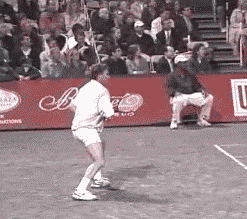
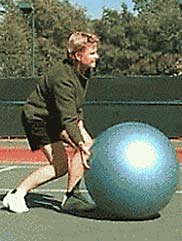
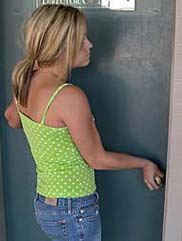
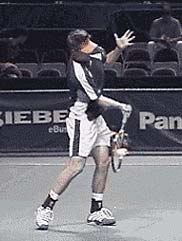

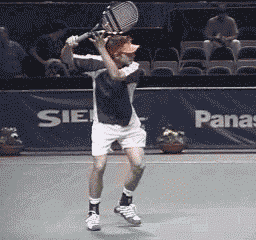
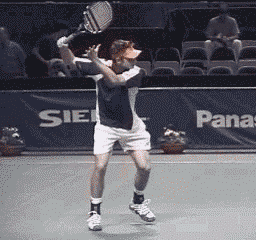
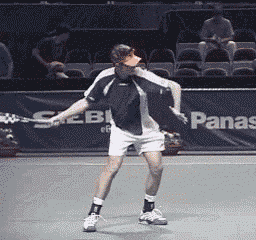
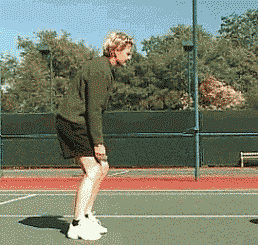
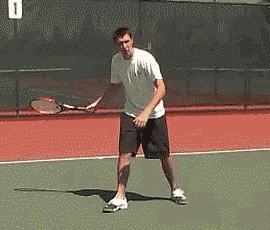
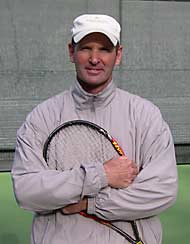
 Doug King studied with legendary tennis coach Tom Stow and was a former California State Men's Singles Champion and the former number one men's player of Northern California.
Doug King studied with legendary tennis coach Tom Stow and was a former California State Men's Singles Champion and the former number one men's player of Northern California.